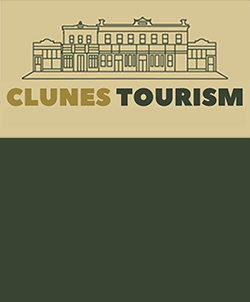History
Clunes was the site of Victoria’s first gold strike. It is located in a steep valley surrounded by rounded hills, which are actually extinct volcanoes. They can be best seen 3 km south along the road to Ballarat.
Clunes is one of the most intact 19th-century towns in the Central Goldfields, boasting numerous bluestone and brick buildings. Fraser St, the commercial centre, is wide and elegant, full of 19th-century shops with original store-fronts and distinctive verandahs. Fraser St has been the setting for many films including ‘Mad Max’ and ‘Ned Kelly’. The Djadja Wurrung people were the first inhabitants and these people occupied most of central Victoria. Being called the “yes people” suggests that the tribe were considered to be a friendly group of people.
Early Settlers
The first European settler, 21 year-old Donald Cameron, an overlander from Sydney, took up a pastoral run in 1839, naming it Clunes after his birthplace in Scotland. The name in Gaelic means ‘a pleasant place’. Major Mitchell passed through Clunes in 1836 and pronounced it ‘good’. The site of the Cameron homestead can be seen along the creek, downstream from the ford about half a mile. In 1847 the station covered 32,000 acres and carried 15,000 sheep and 50 cattle.
Striking gold
Gold traces were first found on this property by a friend, William Campbell, in March 1850, although news of the find was concealed. During the 1840’s there were many rumours of gold being found in the area by shepherds, but the squatters suppressed the evidence to keep the district as a quiet pastoral district. A young man named Chapman took the first sample of gold to a Melbourne jeweller in 1849. It was known by many that the quartz reefs on the Cameron station contained gold, and that many other deposits would be found around this area of the Port Philip Settlement, which was still part of the Colony of New South Wales. When Victoria became a Colony and was separated from New South Wales, a reward for the discovery of gold, to promote a population growth in the new colony, was made by a group of Melbourne business men, who offered the sum of £210 ($420)
In July 1851, James Esmond, who had been to the goldfields of California, came to Clunes and mined some samples from the quartz, then journeyed to Geelong to report the discovery. He reached Geelong on Saturday, 5th July 1851 where his report was received with great enthusiasm. The news was published in the Geelong Advertiser on Monday, 7th July 1851. On Wednesday, 9th July 1851, the Melbourne Daily News reported a find at Anderson’s Creek (Warrandyte) – so the gold rush started in Victoria.
Clunes Mine
In 1857, the Port Philip Company became interested in the Clunes reefs when Mr. Rivett Henry Bland heard of their possibilities. In February of that year, a lease was drawn up with the owners of the land to give the Company the right to mine on the land for 21 years, with the owners to receive 10% of all gold mined. This proved very profitable mining, at first 160 acres then later 50 acres, the royalty amounting to £135,000 ($270,000) in the first twenty-four years.
By the end of 1858 there was plenty of work, the mines were paying well and everyone was prosperous. By this time the population had reached 1,000 and by 1861 had increased to 1,083 and there were 470 dwellings.
Clunes Township
Clunes had now its own council and 292 children attended five schools. The population increased in 1866 to 3,526. There were 8 schools, 850 dwellings, 5 churches, and 7 quartz mines. By 1862 Clunes possessed a Freemasons Lodge, a Manchester United Order, Oddfellows, Forresters, St. Andrews Society, Hiberian Society, Rechabites, Orange Lodge, Protestant Alliance, Good Templars. There were 15 hotels, 12 grocers, 1 baker, 6 butchers, 4 fruit and confectionery shops, 2 restaurants, 4 boarding houses, 2 tailors, 3 drapers, 4 bookshops, 2 painters and paperhangers, 2 ironmongers, 4 blacksmiths, 2 wheelwrights, 2 stationers, 5 churches, 2 doctors, 3 foundries, 1 gas works and several brickmaking yards.
Clunes Tourism and Development Association Inc (CTDA)
The Clunes Tourism and Development Association Inc (CTDA) was one of the longest running membership organisations in Clunes focused on making the town a great place to live, work and visit. They were a committed group of volunteers who contributed their time and expertise to running many of the towns’ regular events, including Australia Day, Clunes Town Christmas Decorations and the monthly Clunes Market. In addition, the CTDA supported other initiatives and projects that improved the amenity and liveability of the town.
An important part of their work involved making representation to local, state and federal government bodies in regard to matters affecting the town, as well as connecting and coordinating with other local community groups and businesses.
The organisation was about supporting the community they all share. Sadly it ceased operations towards the end of 2024.



